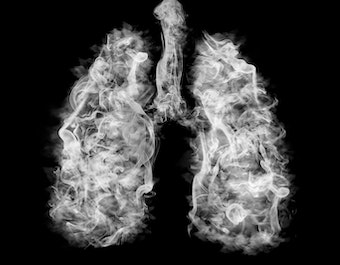Those white clouds that linger after a hit from an e-cig don’t look or smell like traditional cigarette smoke. They don’t hang in the air as long or drift as far, but that doesn’t mean that e-cigarettes are putting out harmless water vapor.
In fact, to get nitpicky about it, e-cigarettes don’t produce a vapor at all, but an aerosol. This aerosol is made up of tiny particles, some of which may contain toxic chemicals that are created when the e-liquid in e-cigarettes is heated. The aerosol may then be breathed deeply into the lungs –– along with the chemicals –– and exhaled.
It’s true that e-cigarette aerosols contain fewer chemicals than the 7,000 found in traditional cigarette smoke, but that doesn’t mean they are safe. E-cigarette aerosol contains many harmful or potentially harmful substances like nicotine, heavy metals, and cancer-causing chemicals.
E-cigarette aerosol unveiled
Exactly what’s in each e-cigarette liquid can vary from brand to brand, but it may contain nicotine, propylene glycol or glycerol (used to turn the liquid into an aerosol), flavorings and other chemicals. Some of those chemicals are already found in the e-liquid, but even more are created when the e-liquid is heated. When propylene glycol or glycerol is vaporized, for example, it may cause two hazardous chemicals, formaldehyde and acrolein, to form.
Here’s a closer look at what may be in e-cigarette aerosol:
- Nicotine. A Centers for Disease Control and Prevention (CDC) study found that 99% of all e-cigarettes contain nicotine, even some that claim they don’t. Nicotine is highly addictive and it’s especially addictive to young brains. That’s because our brains keep developing until about age 25, and nicotine actually changes the way the synapses in our brains form.
- Volatile organic compounds like benzene, which is found in car exhaust. VOCs are the gases that certain liquids or solids produce. Common ones can be found in paint, varnishes and pesticides. At certain levels, VOCs can cause eye, nose, and throat irritation, headaches and nausea, and even liver, kidney, or nervous system damage.
- Heavy metals such as nickel, tin, and lead. These metals could be coming from the metallic coil that heats the e-liquid, other parts of the e-cigarette or the e-liquid itself. When metals like these are inhaled, they can cause coughing, wheezing, chest tightness, or shortness of breath. Metals like nickel and lead are also considered carcinogens.
- Diacetyl. Many flavored e-liquids contain diacetyl, a chemical that’s been linked to lung disease. In fact, it was behind the notorious “popcorn lung” that workers in a microwave popcorn factory developed after breathing in the flavoring used to give popcorn its buttery flavor. This lung disease causes scarring to the lung’s small air sacs, which narrows the airways. One study found that exposure to diacetyl and 2,3-pentanedione, two common chemicals found in e-cigarette flavorings, decreased the number of cells that line the lungs’ airways and help keep them clear.
- Propylene glycol. The chances are good that you’ve probably eaten, or worn, a product containing propylene glycol. That’s because it’s commonly used in food, cosmetics and medicine as an FDA-approved way to absorb extra water to prevent leaking and to keep things moist. The long-term effects of heating and inhaling propylene glycol, however, aren’t well known. But evidence shows that when heated, it can cause eye and throat irritation. Which isn’t surprising when you learn it’s also what’s used in smoke machines.
- Cancer-causing chemicals like formaldehyde and acrolein. It’s unknown if the levels in e-cigarette aerosols are high enough to be carcinogenic, but there is strong evidence that chemicals like these can cause DNA damage.
More research is needed to know the health impacts of long-term exposure to e-cigarettes, but what is already known is that even though the aerosol might look innocuous, it is not harmless.
JENNIFER THOMAS
Rally Health





